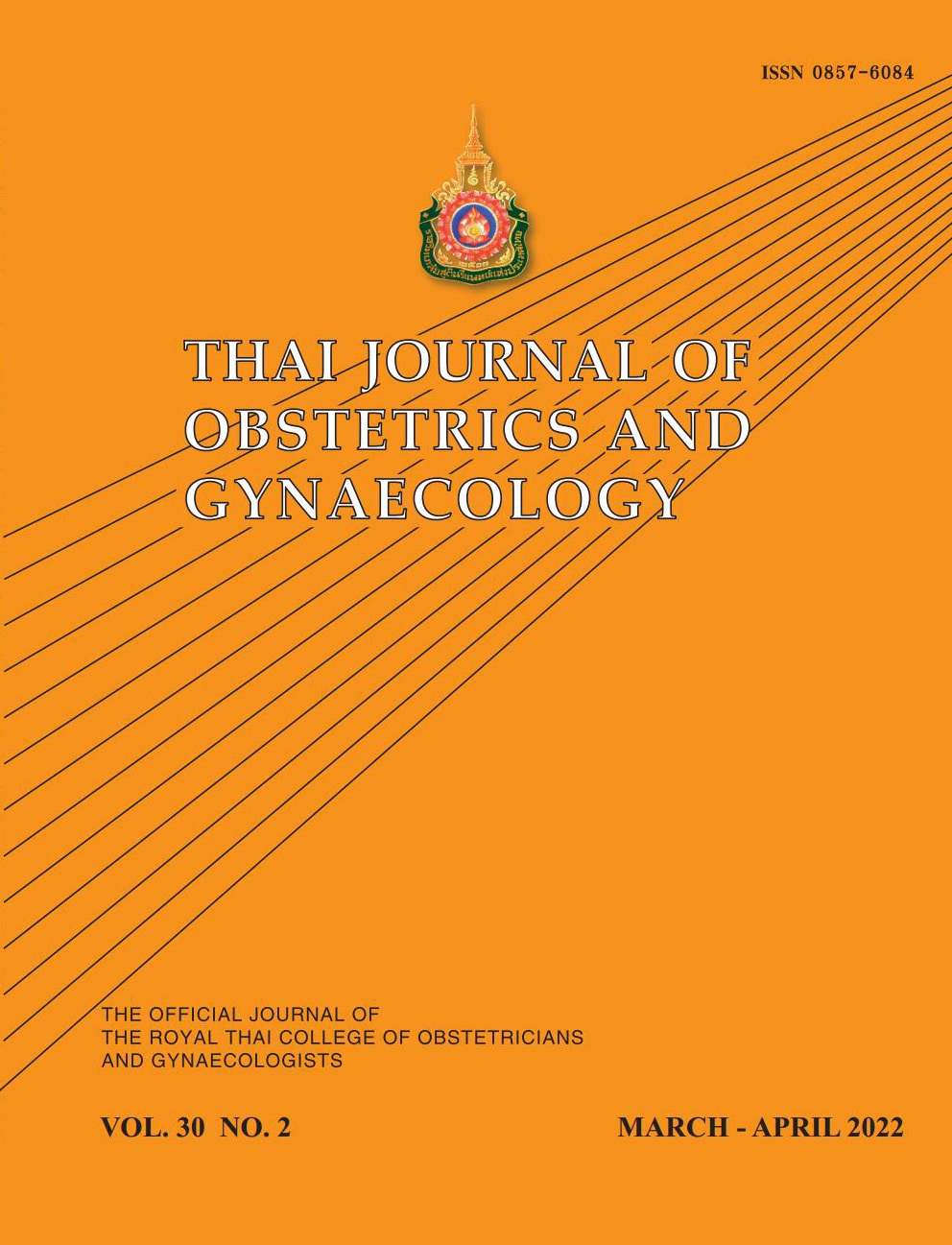Quality of Life after Treatment by Vaginal Pessary versus Surgery in Symptomatic Pelvic Organ Prolapsed Thai Patients
Main Article Content
Abstract
Objectives: To compare the change in quality of life of Thai patients with symptomatic pelvic organ prolapse treated with vaginal pessary or surgery using validated prolapse quality of life (P-QOL) questionnaire.
Materials and Methods: The study recruited patients in one by one stratified simple random sampling in the same prolapse stages of forty patients in the pessary group and forty patients in the surgery group from the urogynecology clinic between January 2018 and August 2019. The data were collected using the P-QOL questionnaire before the treatment and 3 months and 6 months after the treatment.
Results: The mean age was 65.7 ± 7.7 years and body mass index was 24.9 ± 3.7 kg/m2. After treatment with either pessary or surgery, almost all P-QOL domains significantly improved at 3 months and 6 months except in the personal relationships and sleep/energy domains in the pessary group in which the domains were not different from the baseline. General health perceptions and sleep/energy domains significantly improved more in the surgery group at 3 months (p = 0.01 and p = 0.023) and 6 months (p = 0.024 and p = 0.007,) after treatment. The mean ± standard deviation of satisfaction scores after treatment in pessary and surgery at 3 months (8.9 ± 1.4 and 9.3 ± 1.0 (p = 0.509), and 6 months (9.4 ± 1.2 and 9.3 ± 1.1 (p = 1.000) were not statistically different.
Conclusion: The quality of life in symptomatic prolapse after treatment with vaginal pessary or surgery improved. The majority of patients were very satisfied with the outcomes of either treatment.
Article Details

This work is licensed under a Creative Commons Attribution-NonCommercial-NoDerivatives 4.0 International License.
References
Committee on Practice Bulletins-Gynecology and American Urogynecologic Society. Pelvic organ prolapse. Female Pelvic Med Reconstr Surg 2017; 23:353-64.
Digesu GA, Chaliha C, Salvatore S, Hutchings A, Khullar V. The relationship of vaginal prolapse severity to symptoms and quality of life. BJOG 2005;112:971-6.
Bodner-Adler B, Bodner K, Stinglmeier A, Kimberger O, Halpern K, Koelbl H, et al. Prolapse surgery versus vaginal pessary in women with symptomatic pelvic organ prolapse: which factors influence the choice of treatment? Arch Gynecol Obstet 2019;299:773-7.
Coolen A-LWM, Troost S, Mol BWJ, Roovers J-PWR, Bongers MY. Primary treatment of pelvic organ prolapse: pessary use versus prolapse surgery. Int Urogynecol J 2018;29:99-107.
Lone F, Thakar R, Sultan AH. One-year prospective comparison of vaginal pessaries and surgery for pelvic organ prolapse using the validated ICIQ-VS and ICIQ-UI (SF) questionnaires. Int Urogynecol J 2015; 26:1305-12.
Manchana T, Bunyavejchevin S. Validation of the Prolapse Quality of Life (P-QOL) questionnaire in Thai version. Int Urogynecol J 2010; 21:985-93.
Clemons JL, Aguilar VC, Tillinghast TA, Jackson ND, Myers DL. Patient satisfaction and changes in prolapse and urinary symptoms in women who were fitted successfully with a pessary for pelvic organ prolapse. Am J Obstet Gynecol 2004;190:1025-9.
Komesu YM, Rogers RG, Rode MA, Craig EC, Gallegos KA, Montoya AR, et al. Pelvic floor symptom changes in pessary users. Am J Obstet Gynecol 2007;197:620.e1-6.
Coelho SCA, Marangoni-Junior M, Brito LGO, Castro EB de, Juliato CRT. Quality of life and vaginal symptoms of postmenopausal women using pessary for pelvic organ prolapse: a prospective study. Rev Assoc Med Bras (1992) 2018;64:1103-7.
Kuhn A, Bapst D, Stadlmayr W, Vits K, Mueller MD. Sexual and organ function in patients with symptomatic prolapse: are pessaries helpful? Fertil Steril 2009; 91:1914-8.
Yalcin Y, Demir Caltekin M, Eris Yalcin S. Quality of life and sexuality after bilateral sacrospinous fixation with vaginal hysterectomy for treatment of primary pelvic organ prolapse. Low Urin Tract Symptoms 2020;12:206-10.
Mattsson NK, Karjalainen PK, Tolppanen A-M, Heikkinen A-M, Sintonen H, Härkki P, et al. Pelvic organ prolapse surgery and quality of life-a nationwide cohort study. Am J Obstet Gynecol 2020;222:588.e1-588.e10.
Abdool Z, Thakar R, Sultan AH, Oliver RS. Prospective evaluation of outcome of vaginal pessaries versus surgery in women with symptomatic pelvic organ prolapse. Int Urogynecol J 2011; 22:273-8.
Wang Y, Han J, Zhang K, Zhu F, Yang J, Wang Y. Relevance between expectations before treatment, new symptoms and satisfaction after treatment in patients with pelvic organ prolapse. Zhonghua Fu Chan Ke Za Zhi 2015;50:664-7.
Thys SD, Roovers JP, Geomini PM, Bongers MY. Do patients prefer a pessary or surgery as primary treatment for pelvic organ prolapse. Gynecol Obstet Invest 2012;74:6-12.


